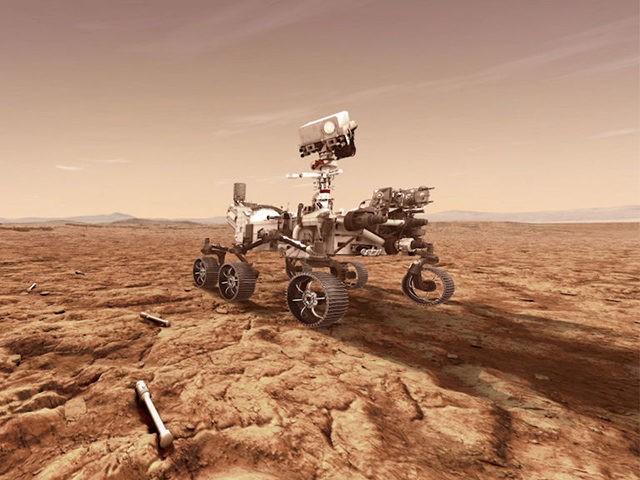As President Joe Biden and other world leaders warn about the dangers of carbon dioxide (CO2) and other greenhouse gases, the National Aeronautics and Space Administration (NASA) is making history on the planet Mars as its high-tech equipment, for the first time, is turning CO2 into oxygen.
This is taking place as NASA also celebrates its third successful launch on of the SpaceX’s Falcon 9 rocket that is transporting four astronauts from the United States, Japan, and the European space program.
The NASA blog reported:
The growing list of “firsts” for Perseverance, NASA’s newest six-wheeled robot on the Martian surface, includes converting some of the Red Planet’s thin, carbon dioxide-rich atmosphere into oxygen. A toaster-size, experimental instrument aboard Perseverance called the Mars Oxygen In-Situ Resource Utilization Experiment (MOXIE) accomplished the task. The test took place April 20, the 60th Martian day, or sol, since the mission landed Feb. 18.
While the technology demonstration is just getting started, it could pave the way for science fiction to become science fact — isolating and storing oxygen on Mars to help power rockets that could lift astronauts off the planet’s surface. Such devices also might one day provide breathable air for astronauts themselves. MOXIE is an exploration technology investigation — as is the Mars Environmental Dynamics Analyzer (MEDA) weather station — and is sponsored by NASA’s Space Technology Mission Directorate (STMD) and Human Exploration and Operations Mission Directorate.
“This is a critical first step at converting carbon dioxide to oxygen on Mars,” Jim Reuter, associate administrator for STMD, said. “MOXIE has more work to do, but the results from this technology demonstration are full of promise as we move toward our goal of one day seeing humans on Mars.”
“Oxygen isn’t just the stuff we breathe,” Reuter said. “Rocket propellant depends on oxygen, and future explorers will depend on producing propellant on Mars to make the trip home.”
The blog said that the red planet’s atmosphere is 96 percent carbon dioxide and MOXIE works by separating oxygen atoms from carbon dioxide molecules, which contains one carbon atom and two oxygen atoms.
“MOXIE isn’t just the first instrument to produce oxygen on another world,” Trudy Kortes, director of technology demonstrations within STMD, said. “It’s the first technology of its kind that will help future missions ‘live off the land.’”
“It’s taking regolith, the substance you find on the ground, and putting it through a processing plant, making it into a large structure, or taking carbon dioxide — the bulk of the atmosphere — and converting it into oxygen,” Kortes said. “This process allows us to convert these abundant materials into useable things: propellant, breathable air, or, combined with hydrogen, water.”
The SpaceX rocket will arrive at the International Space Station on Saturday.
“The Crew Dragon spacecraft, named Endeavour, will dock autonomously to the forward port of the station’s Harmony module about 5:10 a.m. Saturday, April 24,” the NASA blog said.
“It has been an incredible year for NASA and our Commercial Crew Program, with three crewed launches to the space station since last May,” NASA Acting Administrator Steve Jurczyk, said.
NASA reports other “firsts” that will take place with this latest trip to the International Space Station:
- First commercial crew mission to fly two international partners;
- First commercial crew handover between astronauts on the space station as Crew-1 and Crew-2 astronauts will spend about five days together on station before Crew-1 returns to Earth;
- First reuse of the Crew Dragon spacecraft and Falcon 9 rocket on a crew mission — Crew Dragon Endeavour flew the historic Demo-2 mission and the Falcon 9 flew astronauts on the Crew-1 mission; and,
- First time two commercial crew spacecraft will be docked to station at the same time.
“When I see a launch, I immediately think of what it took to reach this milestone and the dedication of all the people who made it happen,” said Steve Stich, manager of NASA’s Commercial Crew Program. “There’s obviously a long way to go, but now we can celebrate the Crew-2 launch and look forward to seeing them join their other Expedition 65 colleagues as we prepare to bring Crew-1 home next week.”
The public can watch the action on NASA Television or the agency’s website. The developments at the space station start at 5:10 a.m. EDT, with a welcome ceremony taking place at 7:45 a.m. EDT.
Follow Penny Starr on Twitter or send news tips to pstarr@breitbart.com

COMMENTS
Please let us know if you're having issues with commenting.